What Are the Top HotDocs Alternatives in 2024? (7 Options)
What Are the Top HotDocs Alternatives in 2024?
HotDocs has been around since the 1990s and has successfully established itself as one of the earliest document automation tools. However, seniority doesn’t always mean it’s the best.
In 2024, law firms need a document management solution that lets them collaborate while checking all the boxes: accuracy, consistency, and compliance.
Does HotDocs meet all these requirements? What are its main features, anyway?
Let’s get to know HotDocs inside out and what it lacks. We’ll discuss the best HotDocs alternatives that could give you the efficiency, affordability, and user-friendliness you need.

What Is HotDocs?
HotDocs is a document automation tool that helps businesses create complex documents quickly and accurately. Imagine being able to generate contracts, forms, and agreements with just a few clicks instead of spending hours drafting each one by hand.
That’s what HotDocs does—it turns your repetitive document creation tasks into a more efficient process.
Here’s how it works: You start with templates, which are pre-designed documents that you can customize. You input your data once, and HotDocs takes care of the rest, filling in the details and making sure everything is correct.
This process saves a ton of time and reduces the risk of errors, which is especially important in fields like law, finance, and real estate, where precision is non-negotiable.
Why Should You Consider a HotDocs Alternative?
While HotDocs is a powerful tool for document automation, it might not be the perfect fit for everyone. Here’s why you might want to explore some alternative tools to create documents, especially legal documents:
Cost Considerations
Let’s face it: HotDocs can be pricey, especially for small businesses or startups watching their budgets. The high cost can be a big barrier.
Many alternatives offer more flexible and affordable pricing plans or even free versions, which can help you save money without sacrificing functionality.
User Interface and Ease of Use
HotDocs packs a lot of power, but its interface can feel like a maze. If you spend too much time figuring out how to use it, that’s a problem.
Many alternatives have simpler, more intuitive interfaces that make getting started and training your team easier. Imagine reducing the time you spend trying to learn the software!
Integration With Other Tools
Good document automation should work seamlessly with the tools you already use. While HotDocs integrates with many systems, it might miss some key ones you rely on.
Some alternatives offer better compatibility and more extensive integration options for a smoother legal workflow. Think of it as finding a tool that fits perfectly into your existing setup without any hassle.
Scalability for Different Business Sizes
HotDocs is great for handling complex needs, but it might be too much if you’re a smaller operation. Alternatively, it might not be flexible enough if you’re a larger business needing extensive customization.
Alternatives often provide scalable solutions that grow with your business, which gives you just the right amount of power and flexibility.
Better Collaboration Features
In today’s collaborative work environment, having the right features to work together is a must. While HotDocs is good, some alternatives shine brighter with real-time editing, team workflows, and sharing options that increase productivity and teamwork.
Customization and Flexibility
Every business is unique, and your document automation tool should be too. Some HotDocs alternatives offer greater customization options, which allow you to tailor the software to fit your needs. This means you can mold the tool to your workflow rather than the other way around.
Plus, you need a tool with legal document templates that fits your area of expertise. For example, if you want a tool to speed up your discovery process, something like Briefpoint.ai is designed specifically for discovery requests and response documents.
7 Best HotDocs Alternatives You Need to Try
What if Hotdocs isn’t serving your needs as well as it should? Well, it might be time to find a document generation solution that fits perfectly in your tool stack.
We’ve compiled some of the best document automation tools that could deliver a significantly better experience for your law firm:
1. Briefpoint
Briefpoint.ai is an AI-powered document automation tool designed to simplify the process of creating legal documents, particularly discovery request and response documents. These include but are not limited to:
- Requests for admission
- Requests for production
- Interrogatories
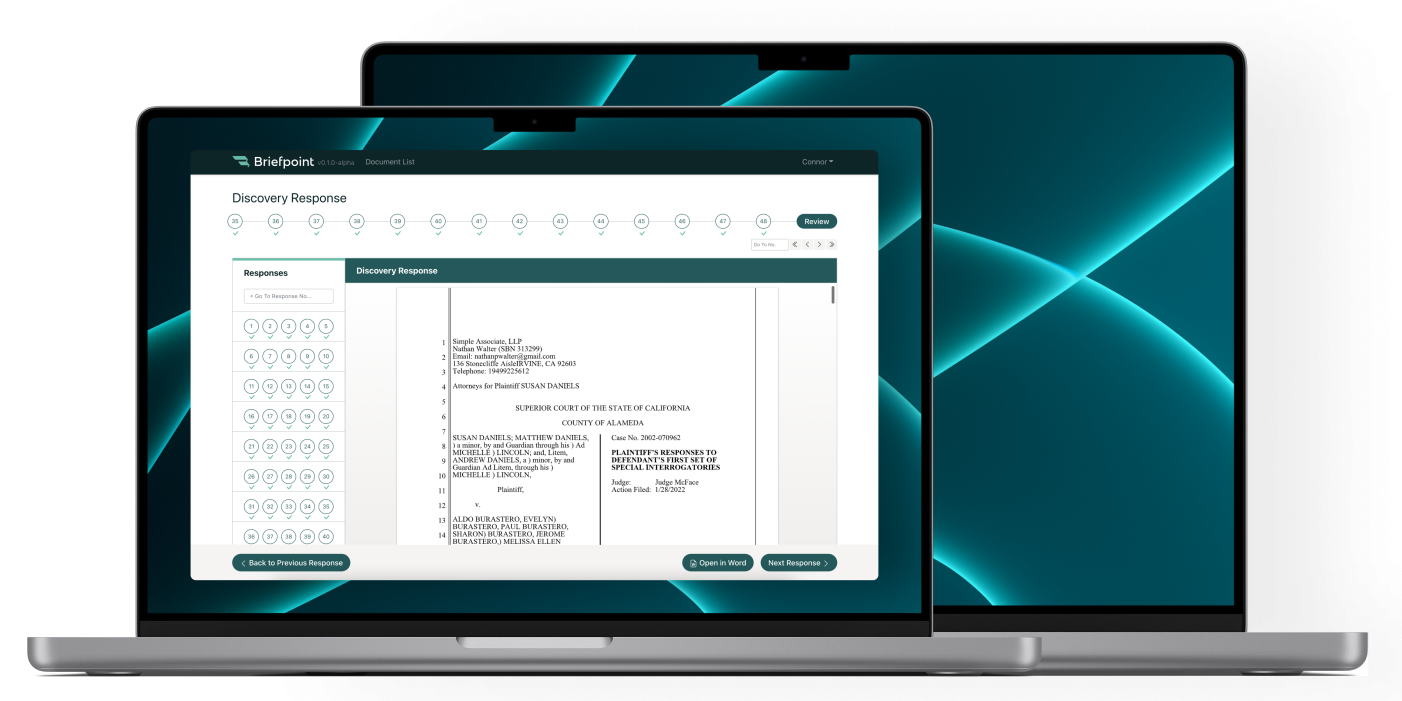
Briefpoint uses a combination of natural language processing and large language models to understand and generate documents based on user uploads, which makes it a perfect fit for lawyers and legal professionals who need to create complex documents at a rapid-fire pace.
Most importantly, the process is extremely simple. You upload the opposing counsel’s discovery request, and Briefpoint’s machine-learning AI system will instantly scan and extract as much information as it can.
Then, the AI will fill out the routine data in your response document and automatically suggest objections to the requests. Briefpoint also has a built-in feature called Bridge, which makes it easy to collect client responses and plug them into your draft.
Finally, you can export your document to Word and put the finishing touches there. The whole process can take as little as a few minutes, compared to hours, if you were to create a whole document manually.
Key Features
- AI-driven document generation
- Template management
- Integration with legal databases
- Customizable clauses and terms
- Supports Word documents
Pros
- Easy to use: The intuitive interface makes it simple for users to get started without extensive training.
- AI-driven: Automates complex legal document creation and minimizes errors from manual data entry.
- Affordable: Offers competitive pricing plans accessible for small to large firms.
2. Legito
Legito is a versatile document automation platform that simplifies the management of different document types. It features automated workflows, customizable templates, legally binding e-signatures, and seamless integration with CRM and ERP systems.
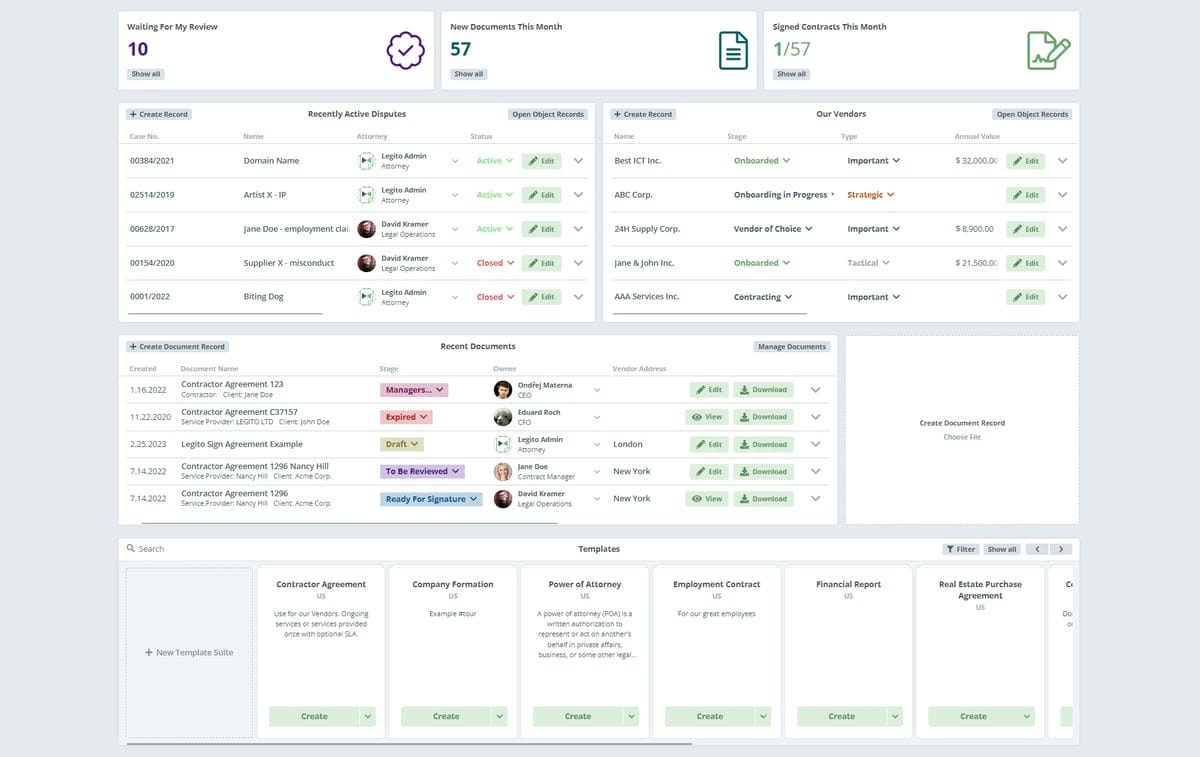
Image sources: G2
For legal professionals, Legito automates the creation of contracts, agreements, and other traditional documents, which cuts down on manual work and produces fewer errors. The interactive templates help ensure compliance and easy customization.
Plus, its document lifecycle management tracks status, manages revisions, and maintains compliance to help save time and increase accuracy.
Key Features
- No-code automation platform
- Interactive templates
- Document lifecycle management
- Integration with CRM and ERP systems
- Legally binding e-signatures
Pros
- Versatile: Supports a wide variety of document types and industries.
- Feature-rich: Includes powerful automation, templates, and e-signatures.
- Collaboration: Excellent tools for team collaboration and real-time editing.
Cons
- Overkill for small businesses: Might offer more features than small businesses need.
- Learning curve: Takes time to learn all the features and fully take advantage of them.
3. Knackly
Knackly lets you simplify document creation with user-friendly templates, easy data importing/exporting, and smart conditional logic. It also integrates well with practice management software, a primary reason why it’s a complete solution for legal document needs.
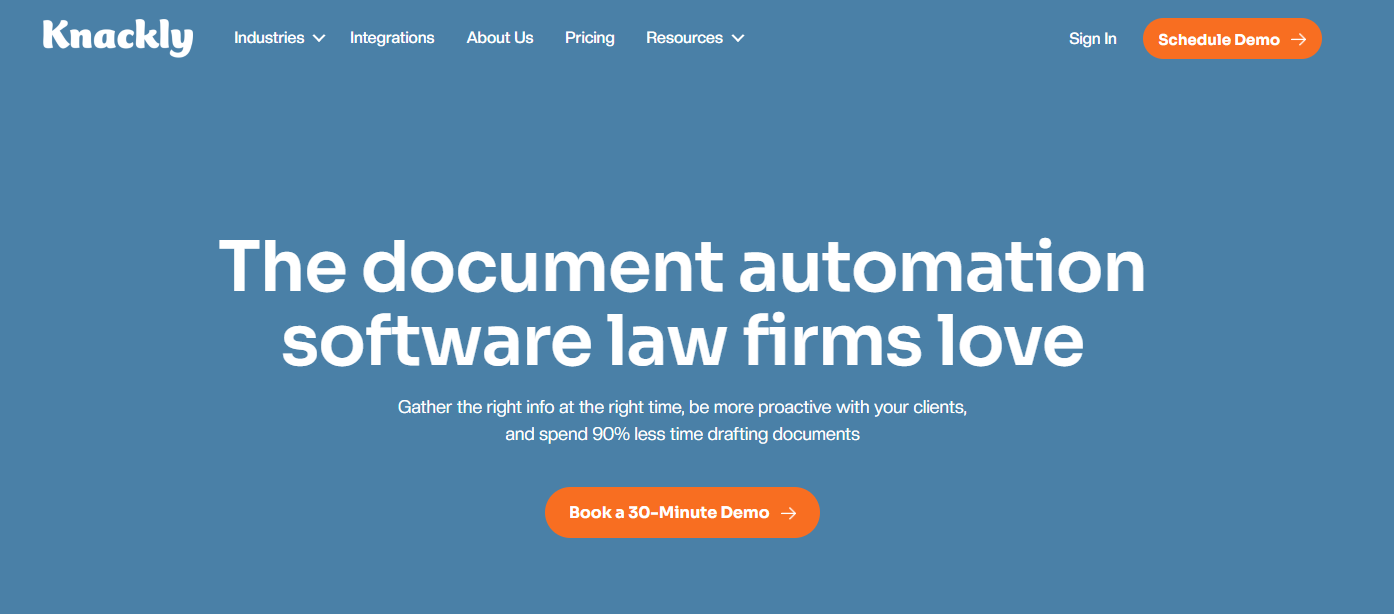
Image sources SaaS Hub
This tool automates legal document generation to help you save time and increase the consistency among your documents. Users create templates with placeholders for variable data, which can be manually entered or imported.
The tool uses conditional logic to tailor document content based on specific criteria for accuracy and customization. Once data is input, Knackly merges it with the templates to generate complete documents.
Additionally, its intuitive user interface means anyone can use it, while features like conditional logic help make sure documents are accurate and compliant.
Key Features
- Template-based document automation
- Integration with practice management software
- Data importing and exporting
- Conditional logic
Pros
- User-friendly: Designed to be easy to use, even for those who aren’t tech-savvy.
- Efficient template management: Simplifies the creation and management of document templates.
- Affordable: Competitively priced, it’s accessible for small to medium-sized businesses.
Cons
- Primarily for legal use: Best suited for legal documents, which might limit its appeal to other industries with very different business processes.
- Limited integrations: It may not integrate with all the software tools a business uses.
4. DocuGenerate
DocuGenerate is an intuitive document automation tool that makes creating and managing documents straightforward and efficient. It offers features like data merging, conditional logic, and support for various file formats.
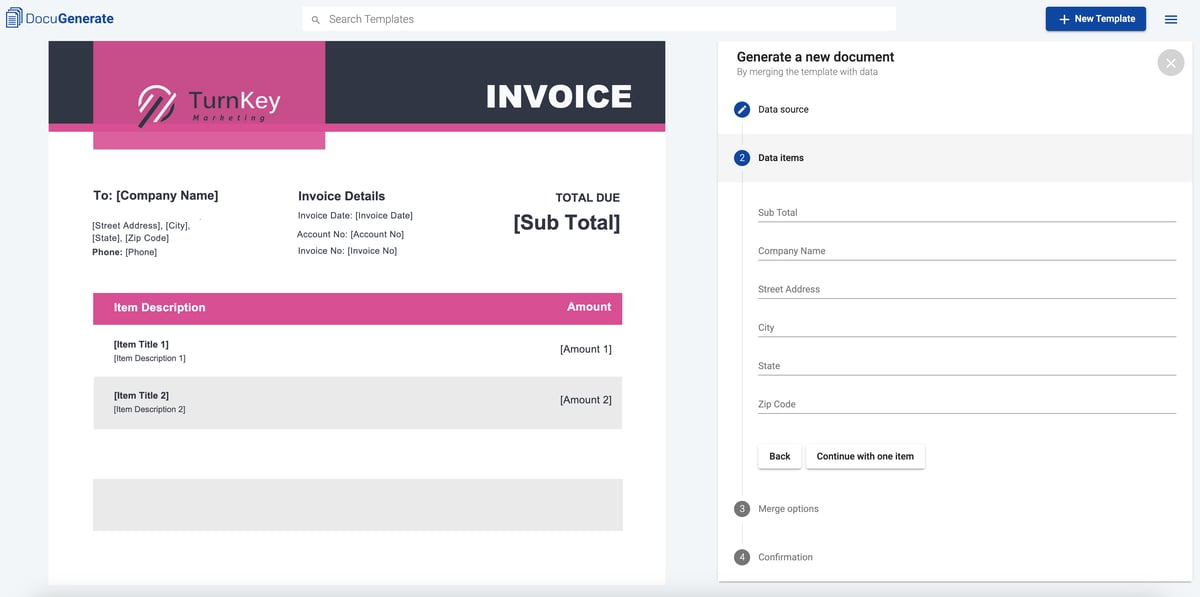
Image sources: G2
With easy integration into cloud storage, it also provides flexibility and ease of access no matter where your team members are.
How does it work? DocuGenerate automates document creation by allowing users to create templates with fields for data merging. Then, users input data, and the tool fills in the templates accordingly with conditional logic to guarantee accuracy and customization.
Key Features
- Data merging
- Conditional logic
- Multiple file format support
- Integration with cloud storage
Pros
- Flexible pricing: Offers a range of pricing options, including a free tier.
- Easy integration: Works well with various cloud storage and other business tools.
- User-friendly: Simple interface that makes document automation accessible to everyone.
Cons
- Advanced features need configuration: Some of the more advanced features might require additional setup.
- Limited advanced functions: Might not have all the advanced capabilities that larger businesses need.
5. PandaDoc
Next up is PandaDoc, a document assembly tool that allows users to create documents using customizable templates, which can be easily edited and personalized. You can add and sign documents electronically and collaborate with team members in real time.
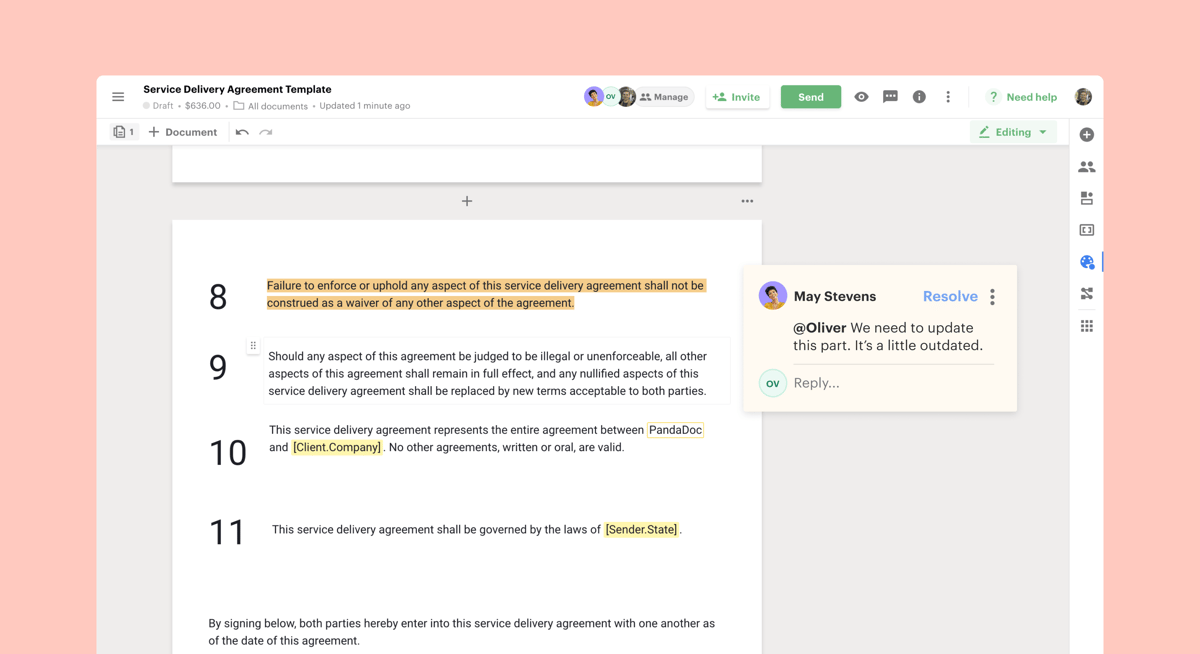
Image sources: G2
At the same time, the platform tracks document progress and provides analytics on document interactions so that you stay informed about how documents are being used.
Key Features
- E-signatures
- Document templates
- Real-time collaboration
- Analytics and tracking
Pros
- Lots of features: From e-signatures to analytics, PandaDoc covers a lot of ground.
- Excellent collaboration tools: Great for teams needing to work together on documents.
- Free plan available: Offers a free tier for businesses to try before committing.
Cons
- Can be pricey: The more advanced features come with higher costs.
- Occasional bugs: Some users report occasional issues and bugs.
6. Juro
Juro is a contract automation platform designed to simplify the management of legal agreements. It allows users to create and manage contracts using easy-to-customize templates. To further simplify the contract lifecycle, you can add e-signatures and automate workflows.
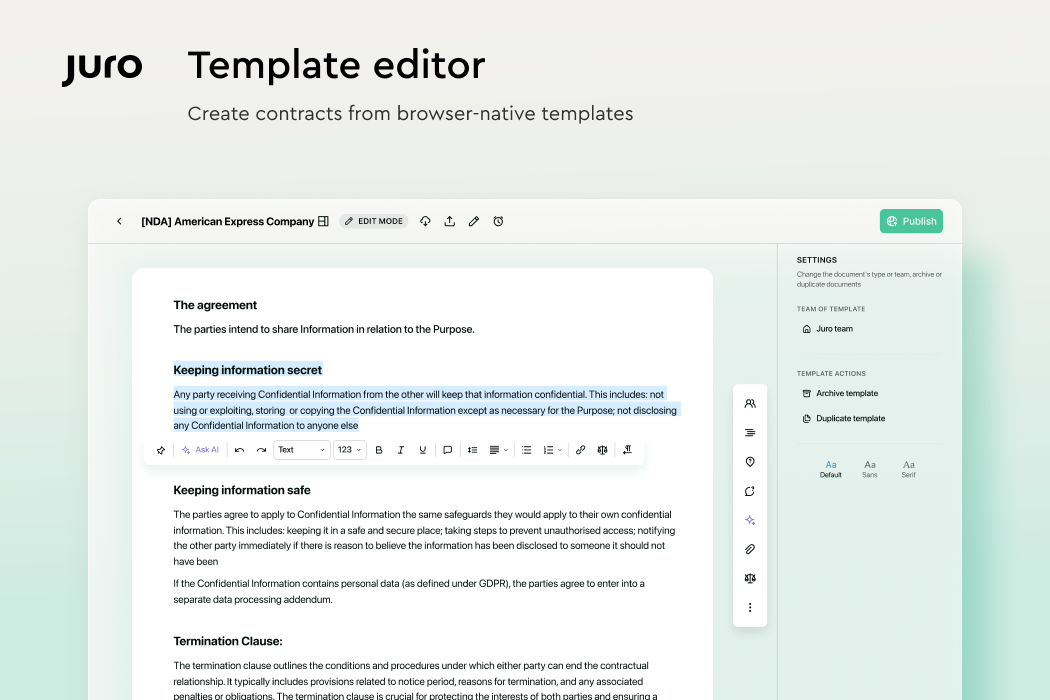
Image sources: G2
Juro is perfect for legal professionals who handle a high volume of contracts. It reduces manual work, minimizes errors, and speeds up the contract management process—all making it a useful tool for improving efficiency and productivity.
Key Features
- Contract automation
- E-signatures
- Customizable contract templates
- Workflow management
Pros
- Specialized for contracts: Perfect for businesses that need to manage contracts efficiently.
- Intuitive interface: Easy to use, with a clean and simple design.
- Good customer support: Responsive support to help with any issues.
Cons
- Limited to contracts: Best suited for contract-related documents, which might not cover all needs.
- Higher pricing for advanced plans: The more advanced features can get expensive.
7. Proposify
Proposify is a document generation and management solution specifically for business proposals. It allows users to create professional proposals using customizable templates tailored to specific needs. This can help sales teams looking to speed up their proposal process.

Image sources: G2
Key Features
- Proposal templates
- E-signatures
- Detailed analytics
- Team collaboration
Pros
- Suitable for sales proposals: Tailored for creating and managing proposals, focusing on the sales process.
- Detailed analytics: Provides insights into how proposals are viewed and interacted with.
- Collaborative features: Great for teams, with real-time collaboration tools.
Cons
- Limited to proposals: Primarily designed for proposals, which might not meet all document needs.
- Can be too focused: Some users might find it too specialized and lacking in broader document automation features.
Why Briefpoint Is the Best HotDocs Alternative
Looking for the best alternative to HotDocs? You’re just in the right place.
Briefpoint will transform your discovery process with its AI-driven tech, which speeds up and simplifies document creation—less fuss, and fewer mistakes. It’s incredibly user-friendly, so you can hit the ground running without navigating through complicated setups.
Plus, it’s tailored for legal professionals so that all your documents meet compliance standards without extra hassle. And if you ever get stuck, their customer support is just a quick call or click away.
Book a demo today and see the difference.
Why Choose Briefpoint?
Discovery responses cost firms $23,240, per year, per attorney. $23,240 estimate assumes an associate attorney salary of $150,000 (including benefits – or $83 an hour), 20 cases per year/per associate, 4 discovery sets per case, 30 questions per set, 3.5 hours spent responding to each set, and 1800 hours of billable hours per year.
Book a demo and save on these costs with Briefpoint.
FAQs About HotDocs Alternatives
What features should I look for in a HotDocs alternative?
When choosing a HotDocs alternative, focus on customization options to create templates that fit your needs, integration capabilities with your current tools, and ease of use to minimize the learning curve. Also, consider the pricing and scalability to make sure it suits your budget and can grow with your business.
How do HotDocs alternatives compare in terms of pricing?
HotDocs alternatives generally offer more flexible and clear pricing options. Many provide free trials or basic plans, which are great for small businesses or startups. Subscription models with different feature levels let you pick a plan that fits your needs. In contrast, HotDocs might have a more complex and expensive pricing structure, which may not be as budget-friendly for smaller organizations.
How easy is it to switch from HotDocs to another tool?
Switching from HotDocs to an alternative can be pretty straightforward with the right help. Many alternatives offer migration assistance and detailed setup guides to make the transition smooth. They often have data import features to transfer your existing documents and templates seamlessly, along with customer support to assist with any issues during the process.
The information provided on this website does not, and is not intended to, constitute legal advice; instead, all information, content, and materials available on this site are for general informational purposes only. Information on this website may not constitute the most up-to-date legal or other information.
This website contains links to other third-party websites. Such links are only for the convenience of the reader, user or browser. Readers of this website should contact their attorney to obtain advice with respect to any particular legal matter. No reader, user, or browser of this site should act or refrain from acting on the basis of information on this site without first seeking legal advice from counsel in the relevant jurisdiction. Only your individual attorney can provide assurances that the information contained herein – and your interpretation of it – is applicable or appropriate to your particular situation. Use of, and access to, this website or any of the links or resources contained within the site do not create an attorney-client relationship between the reader, user, or browser and website authors, contributors, contributing law firms, or committee members and their respective employers.